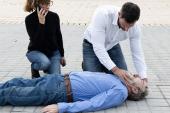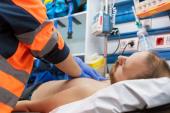EMERGE: Early Angiography Doesn’t Boost OHCA Survival After NSTEMI
With four trials cementing the futility of early imaging in NSTEMI OHCA, the next challenge is to look for any subgroup benefits.

The results, published online in JAMA Cardiology, match those from three other RCTs: TOMAHAWK, COACT, and PEARL. The DISCO trial, in Sweden, is ongoing.
Yet numerous observational studies have suggested a benefit to the early-angiography strategy, Christian Spaulding, MD, PhD (European Hospital Georges Pompidou, Université Paris Cité, France), senior author of the new paper, told TCTMD. Heading into EMERGE, “when we wrote the protocol, we were hoping that there was going to be a difference in favor of doing an immediate coronary angiogram,” he said, noting that it was designed to show superiority.
Based on EMERGE and the trials that preceded it, Spaulding predicted that future guidelines will specify that you don’t have to do an emergent angiogram. “Having said that, there’s no difference in mortality between [the two], so the physicians who want to do an immediate coronary angiogram can do it. They’re not harming their patients. I’ve got some of my colleagues who would say, ‘Well, thanks a lot for your [trial] results, but I’m going to continue doing coronary angiogram in all my patients who’ve a cardiac arrest,’” Spaulding said.
Commenting on the study for TCTMD, Steffen Desch, MD (Heart Center Leipzig, Germany), who led the TOMAHAWK trial, noted that EMERGE, while confirmative, was “a little underpowered,” because it was stopped early. “Otherwise”, he pointed out, “it would have been the largest of these trials.”
A challenge in this area is that “in a lot of these cases, . . . even if you treat the cardiac injury you will still face a majority of these patients [eventually dying] from neurological injury,” he noted. “That’s probably also one of the reasons why these trials are neutral.”
While immediate angiography doesn’t make sense as a universal strategy for all, still there may be niche indications, Desch added, echoing Spaulding’s point that no harm was demonstrated with the early approach. “In an individual case where you have a high suspicion of ongoing myocardial infarction and you think the neurological prognosis is probably good because of short resuscitation times and so on, it’s not forbidden to go this way,” he agreed.
What’s needed next, Spaulding said, is to pinpoint exactly which subsets are most apt to benefit—something the RCT data, taken together, may be useful for teasing out.
The EMERGE Trial
Led by Caroline Hauw-Berlemont, MD (European Hospital Georges Pompidou, Université Paris Cité), the EMERGE researchers had initially planned to enroll 970 patients. Funding of the study was contingent on reaching a target of 50% enrollment at 2 years. But within the first 18 months they’d recruited just 279 patients, which led to the study’s early halt.
Among these 279 participants, the mean age was 64.7 years and 30.1% were women. Around two-thirds had a nonshockable rhythm. The mean time between randomization and angiography was 0.6 hours in the emergency group and 37.2 hours in the delayed group.
Of the 126 patients in the emergency group that ultimately underwent angiography, 45.2% were found to have no significant CAD. In the delayed group, 74 underwent angiography and 55.4% lacked significant CAD. More patients underwent PCI in the emergency group than in the delayed group (30.2% vs 23%). For those who didn’t undergo PCI, the main reason was absence of significant lesions or clear culprit lesions.
The study’s primary endpoint, survival at 180 days in patients with no or minimal neurologic sequelae (defined as Cerebral Performance Category [CPC)] of 2 or less), did not differ between the two strategies, at 34.1% with emergency angiography and 30.7% with delayed (HR 0.87; 95% CI 0.65-1.15; P = 0.32). There were no differences when looking at survival irrespective of CPC. Also similar between groups were secondary endpoints that included shock, tachycardia, and/or fibrillation within 48 hours of admission; changes in LVEF between baseline and 180 days; major neurologic sequelae (CPC score 3 or 4) at ICU discharge and 90 days; and hospital length of stay.
The researchers also did a meta-analysis that pooled data from all four RCTs, with a total of 1,446 patients. Again, the results were similar.
Next Questions
Given the gap between what’s consistently been seen in registries—totaling nearly 6,000 patients—compared with the trial setting, said Spaulding, the question going forward is: why?
Spaulding’s hypothesis is that the registry patients sent to the cath lab were chosen for a reason and thus more likely to do better with the emergent strategy. “Maybe the paramedics in the US and the emergency physicians in Europe selected patients that had a high rate of survival after the out-of-hospital cardiac arrest,” he suggested, “this is why in the registries there is a benefit of performing a coronary angiogram and there is no evidence in the randomized studies.”
These factors are well known and captured by risk scores like MIRACLE2, Spaulding noted. “If patients are young, if there’s a very short delay between the onset of cardiac arrest and the beginning of basic life support, if patients have a shockable rhythm [then] they have a higher probability of surviving compared to the other patients.”
Clinicians can use such characteristics to guide decision-making, he explained, with the hope that “these patients may benefit from immediate coronary angiogram.”
For other cases, where deferral seems best, added Spaulding, “obviously, don’t close the door completely—if a patient is in the intensive care unit and either develops shock or ST-segment elevation or [ventricular tachycardia/ventricular fibrillation], do the coronary angiogram immediately.”
Another “major issue that’s open for further research,” Desch said, relates to the fact that “there’s such a large portion of these patients that will eventually die from neurological injury. If we could somehow sort out these patients and do a trial specifically in patients with supposedly good neurological prognosis”—such as by using the MIRACLE2 score—“the results might be a little different,” even if other aspects of the trial design were the same. Additionally, only patients who are truly experiencing MIs will benefit from percutaneous interventions, he specified.
“The real gold digging, I’d say, in out-of-hospital cardiac arrest is in the prehospital phase; it’s not in the hospital, in the cath lab. In some cases, yes, but in the majority of case it’s much more important to keep the time from arrest to somebody starting resuscitation measures very short. That’s what we have to work on. . . . If it’s more than 3, 4, 5 minutes you will have a bad outcome no matter what you do later on,” Desch concluded.
Caitlin E. Cox is News Editor of TCTMD and Associate Director, Editorial Content at the Cardiovascular Research Foundation. She produces the…
Read Full BioSources
Hauw-Berlemont C, Lamhaut L, Diehl J-L, et al. Emergency vs delayed coronary angiogram in survivors of out-of-hospital cardiac arrest: results of the randomized, multicentric EMERGE trial. JAMA Cardiol. 2022;Epub ahead of print.
Disclosures
- Hauw-Berlemont reports receiving grants from the French Ministry of Health during the conduct of the study.
- Spaulding and Desch report no relevant conflicts of interest.





Comments